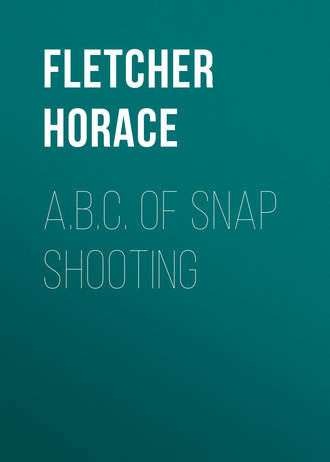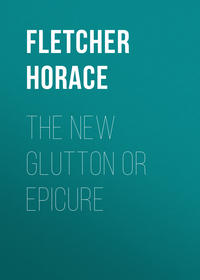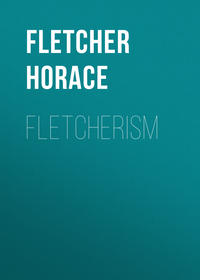 полная версия
полная версияA.B.C. of Snap Shooting
The speed of a bullet diminishes as it travels, and as it requires much greater time to make the second than the first hundred yards, gravity has more time to depress it in that distance.
In bending backwards to shoot, remember that the rifle is inverted.
The flight of a bullet is not in a perfect curve; at first it travels almost straight, then curves gradually, then abruptly, till finally when it has lost its momentum, it drops perpendicularly, affected only by gravity.
If you are stationary and your target moves, aim ahead.
If you are in motion and your target is stationary aim behind, because your motion is given to the bullet.
If you and your target are both moving in the same direction at the same speed, near each other, aim at it, but if the distance be great, aim ahead, because your target keeps up its speed, while the momentum which you have given the bullet decreases as it travels.
The force of wind being irregular and capricious must be judged from personal observation and experience, but remember, that like gravity, it has more time to deflect a bullet during its second than during its first hundred yards flight.
Hold the gun firmly against your shoulder to prevent its kicking.
To counteract recoil, hold yourself against it by making a slight movement forward as you fire.
The general fault in aiming, in snap shooting, is over-aiming.
The front sight should always be brought well down in the rear sight, which is facilitated by having sufficient drop to the stock of the piece.
Aim at an object going straight away from you, as if it were rising.
TARGET PRACTICE
COMPARED WITH SNAP SHOOTING
The shooting at still targets, either off-hand or from a rest, judging windage and the elevation required, nice cleaning, regular loading, etc., are very scientific and good practice for sharp shooting, but unfit one for snap shooting.
To be able to judge distance, windage, the height above or depression below the level, the speed and direction the object is moving, while you count one, two, three, is the skill which this system endeavors to teach, and which is solidly practical.
To stand for one or two minutes, with the elbow resting on the hip, and the hand twisted in an awkward position underneath the trigger guard waiting for a season of partial paralysis to steady the aim, for any purposes other than sharp shooting, is unpractical.
To rest, either standing or lying is more unpractical still.
To be able, in spite of shaky nerves, to throw the rifle, bullet and all at the object in an instant, is practical.
A good snap shot can shoot better off-hand than from a rest, and does not close either eye, when he aims.
Keeping both eyes open comes unsought with practice, and indicates that the gun has become the servile weapon, which finds its way to its place between the eyes and the object, without demanding attention, and delivers its charge direct at the bidding of the master, whose both eyes are intently watching the course of the target.
The brain and finger become so sympathetic that the firing is done almost without bidding.
RULES
TO GOVERN COMPETITION IN SHOOTING AT BELL OR GLASS BALLS WITH A RIFLE, WHEN THE BALLS ARE THROWN UP BY HAND PERPENDICULARLY.
1. The standard calibre of the rifle shall be .22, and the standard distance fifteen feet.
2. Rifles of .28 calibre shall be handicapped two feet, those of .32 calibre four feet, those of .38 calibre eight feet, those of .40 calibre ten feet, and those of .44 calibre twelve feet.
3. The Referee, whose decision shall be final, shall take position on a line at right angles to that between the firer and tosser, opposite the tosser, and see that no balls are thrown inside a perpendicular to that line. In case a ball be hit inside the perpendicular, it shall count neither for nor against the firer.
4. The Firer shall shoot at twenty balls and then retire, must keep the stock of his rifle below his right elbow till the ball is thrown, must shoot at each ball he orders or lose it; is responsible for the throwing of his tosser, whom he is at liberty to choose or change at will, and also for any failure to load or cock his rifle; but is entitled to another ball, if there be a misfire on account of a defective cartridge.
5. Ties shall be shot off on time; the contestant hitting the greatest number of balls in five minutes, shooting as he pleases, at balls thrown according to the rules, shall be declared winner of the tie, provided, of course, that rifles of the same class be used by both parties.
TO GOVERN COMPETITION IN SHOOTING AT BELL OR GLASS BALLS THROWN FROM A TRAP.
1. The same trap shall be used by all contestants, and shall be made to throw the balls as nearly horizontal as possible, and so that they shall fall about twenty-five feet distant, all in the same direction.
2. Rifles of .22 calibre are standard, and entitle the firer to stand three feet in rear of the trap. Firers using .28 calibre rifles shall be handicapped to five feet back of the trap; those using .32 calibre, to seven feet back; those using .38 calibre, to eleven feet back; those using .40 calibre, to thirteen feet back; and those using .44 calibre, to fifteen feet back.
3. The Referee's decision shall be final, and he shall judge, among other points, if the trap throw equally for all.
4. The Firer shall shoot at twenty balls and then retire, must keep the stock of his rifle below his right elbow till the trap is sprung; must shoot at each ball he orders or lose it; is responsible for the service of his trap-puller, whom he is at liberty to choose or change at will, and also for any failure to load or cock his rifle; but is entitled to another ball in case there is a misfire on account of a defective cartridge, or on account of the breaking of the trap.
5. Ties shall be shot off on time; the contestant hitting the greatest number of balls in five minutes, shooting as he pleases, at balls thrown according to the rules, shall be declared winner of the tie; provided, of course, that rifles of the same class be used by both parties.
EXHIBITION SHOTS
AT STILL OBJECTS, AND HOW TO MAKE THEM
Shooting at a Bell-Ball, suspended by a wire about five feet in length, at a range of from thirty to fifty feet.
1. Rifle Canted Sideways. Aim at half-past one o'clock, two inches off.
2. Rifle Upside Down over the head. Aim at twelve o'clock, three inches off.
3. Mirror Shot. Stand with back to the target, rest the rifle on the shoulder, hold a small hand mirror back of the sights, and see the reflection of the target in a line with them. Aim at the target. This shot is difficult, because a change of position of the mirror has the same effect as moving the rifle, and steadiness of both is requisite; also, movements are seemingly reversed in the glass.
4. Snuffing a Candle. The wick must be cut by the bullet.
5. Exploding Cartridges. Shoot ten holes in a plank, place a cartridge in each hole, and explode them in ten shots. This shot is very interesting, but dangerous if the cartridges are pushed into the holes so that the shell is inserted, because a resistance is made, and the shells or parts of them are forced back towards the firer. The end only of the bullet should be covered, and then there is no danger.
6. Card Shot. Cut a hole, the size of the barrel, in an ordinary business card, and slide it on as far as the forward sight. In looking along the line of sights with one eye, the target will be obscured; but if both eyes are left open, there will appear to be a hole in the card through which the target can be seen. The reason of this is, that while one eye looks at the sights and card, the other looks past the card at the target, and, of the double impressions conveyed to the brain, the more distinct ones of the target and sights unite in one and displace the card. In this shot aim a little to the left, the more, the nearer the target is to you, because the eyes are not focussed on the object, but are looking in parallel directions, consequently the discrepancy of aim is the distance between the eyes.
7. The Bending Backward or "Athletic Shot" is very difficult for any but gymnasts, or those who have very limber backs. Stand with the back to the target, put the rifle to the shoulder as if aiming horizontally; bend backward till you are aiming at the target with inverted rifle. Aim high, as in any shot where the rifle is turned barrel down.
8. The Hip Shot is made by holding the stock of the rifle on the hip and judging the aim. It is very difficult, but not all chance, for one can observe how his arms are held, and soon learn to feel if the aim be accurate.
9. Bending forward and Shooting Between the Legs, holding the rifle Back of the Neck, and similar unusual shots, are good practice, and teach one to overcome adverse positions.
10. Knocking the Ashes off a Cigar in an attendant's mouth, or apples or potatoes from his head, are fool-hardy shots, which are not brilliant, and only interest because they are dangerous. No man is sure of himself, his cartridges, or his rifle. Nervousness, a dirty rifle, a bullet which does not fill the grooves, the unsteadiness of the attendant, or other causes of inaccuracy are within the range of possibility, and any danger, especially where another is liable to be the sufferer, should be avoided and discouraged by audiences.
AT MOVING OBJECTS1. Shooting at a Swinging Bell and hitting it in various positions.
2. Shooting at Bells thrown up perpendicularly.
3. Turning Shot. Stand with back to the target and turn and hit the bell after it is thrown.
4. Hit Bells, holding the rifle in One Hand.
5. Toss the Bell up yourself and hit it, using one or both hands.
6. Cross Shot, Drop Shot, Incoming Shot, and Trap Shooting, explained in Rules for Practice.
7. Shooting at coins thrown in the air is interesting, but expensive.
SHOTS WHICH CAN ONLY BE MADE WITH A REPEATING RIFLE1. Double Shot. Hitting two objects thrown in the air at the same time, reloading the rifle once.
2. Triple or Quadruple Shot. Firing into the air two or three times after an object has been thrown, and hitting it with the third or fourth bullet before it reaches the ground.
3. Jump Shot. Place a light ball, either glass or wood, on the ground three feet in front of you. Shoot three inches under it, which will project it into the air. Reload your rifle, and hit it before it falls.
4. Shoot as many Holes as you can in a Board, one foot square, which has been thrown in the air, before it reaches the ground.
5. Break a Brick with one bullet, then reload, and hit one of the pieces.
6. Oranges, when hit hard with a bullet from a .44 calibre rifle, disappear in a shower of juice; or, if struck only lightly with the first bullet, can be hit again with a second before falling.
7. In Time Shooting with a repeating rifle, balls can be hit as fast as they can be thrown up, one at a time, by one person.
Note. —The above repeating rifle shots, and many of the others, were invented by Dr. Carver and successfully made in his various exhibitions in this country and at the Crystal Palace, near London.
FEATS
WHICH HAVE BEEN ACCOMPLISHED WITH THE RIFLE ON MOVING OBJECTS
The records given below have not been made in matches but in exhibitions, but are well authenticated, and will serve as Standards of Excellence.
Dr. William F. Carver, the originator of ball shooting with a rifle, to whom great credit is due on that account, has performed many remarkable feats in his exhibitions, and one of both skill and endurance which will stand for them all.
At Brooklyn Driving Park, on Saturday July 13, 1878, he attempted to break 5500 glass balls in 8 hours, with the following result, copied from the account in Forest and Stream, Rod and Gun:
OFFICIAL TIME RECORD

1Rest of 32 minutes included. Actual breaking time, 6m. 30s.
During this shoot, he used five Winchester Repeating Rifles, weighing about ten pounds each, the aggregated weight of which, raised 6212 times, was about thirty-one tons. Before the first thousand had been broken, the balls of his eyes became sunburned, and being further irritated by rubbing them with his powder-stained gloves, the pain became excruciating, but he hung to his self-imposed task and accomplished it, and left the field in company with the writer, physically unstrained. It is true that the greater number of balls were broken within fifteen feet of the end of the rifle, but it was nevertheless a wonderful exhibition of skill and endurance.
The working of the levers of the rifles, which, when heated, are said to resist over thirty pounds pressure, with the middle finger of the right hand, 6212 times, was a monstrous task in itself.
In exhibiting before the Prince of Wales at Sandringham, he broke 100 balls consecutively, and successfully made nearly all of the various shots described here.
John Ruth, of Oakland, California, who was a companion of Carver during his preliminary practice, has become a successful exhibitor, and has taught his wife to shoot nearly if not quite as well as himself. At Badger's Park, in an exhibition, he hit the bell-ball 990 times out of 1000 shots, as referred to previously.
John E. Graham, of Erie, Pennsylvania, is reported to have made 986 hits in 1000 shots, or only 4 less than Ruth.
George A. Meares of Salt Lake City, who is the champion rifleman of Utah, is enthusiastic in recommending this method, and claims to have derived immense benefit from it.
The late Major Thornburg was very successful at this kind of shooting, as well as perhaps hundreds of others, who have so practiced as to be able to hit 95 per cent. of balls thrown perpendicularly, but who have yet to get the best benefit from the various shots which are here recommended.
The writer, after having practiced an hour each day for about three weeks, gave a private exhibition before numerous German army officers, members of shooting clubs, and others, at Frankfort-on-the-Main, in which he made the following scores at balls thrown in the air, besides successfully making the other shots spoken of:
Ninety-nine out of 100 balls thrown up perpendicularly; 10 Turning Shots; 10 One-handed Shots; 1 °Cross Shots; 10 Drop Shots; 10 Incoming Shots; 17 out of 20 from a Bogardus trap; 19 out of 20 English Pennies.
An English gentleman, who was spending his vacation in Frankfort, and who was a very indifferent shot-gun shot, practiced under instruction at the same time, and as a result, before he left for home, went out several times with parties of the best shots in the vicinity, and bagged more birds than any.
FORMING CLUBS
A range of 100 feet and a bulkhead 25 feet square is all that is required to make perfect facilities for shooting at reduced still, or running targets, or at balls thrown in any direction; and for ball shooting only, a range of 30 feet is sufficient.
A club of ten or twenty can build and run such a range anywhere, even within city limits, at a very light expense; or it is exceedingly profitable to run one and charge for the shots or ammunition, as a private enterprise.
In this manner unlimited practice can be had at a very light expense.
THE MILITARY AND SNAP SHOOTING
It may be offered, simply as a suggestion, that the method of practice recommended in the preceding pages, might be of service in teaching recruits to handle firearms.
Practice in hitting moving objects inspires a confidence which can not be obtained in any other way, and the repetition of the three motions of loading, extracting, and aiming and firing, habituates the learner to a free use of the arms and a confidence in pulling the trigger.
In the German army they aim and snap an unloaded piece repeatedly as an exercise, considering the pulling of the trigger a necessary finish to the motion of aiming.
Aided by a minimum expense, light report, easily-acquired range facilities, and a most-fascinating system, might not the practice be carried to firing and hitting, which is the desired result?
This need not at all interfere with the manual, but can be practiced as an outside exercise; and the result of adopting it would be felt immediately by a company, not only in the ease and quickening of motion and the improved marksmanship, but in the increased interest it would create among the members.







